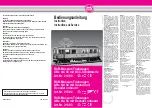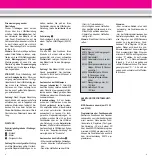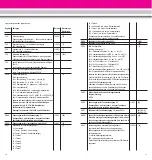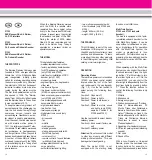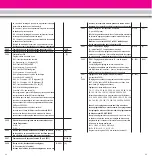
- two multi-purpose sockets with
circuit breakers (only 21392 and
21393)
- length: 635 mm (25.0 in.)
- weight: 3900 g (8.6 lb.)
THE PROGRAM
This LGB model is part of the com-
prehensive LGB program of more
than 600 quality G-scale trains, track
sections and accessories. To learn
more about the many other products
in the LGB program, see the big LGB
catalog or visit www.lgb.com
OPERATION
Operating Modes
There are two power control switches
(21390: one power control switch)
located under the roof of the front
cab (underneath the pantograph)
(Fig. 1, 2). Use the front switch to
select among the following func-
tions:
Position 0: All power off
Position 1: Power to lights
Position 2: Power to motors and
lights
Position 3: Power to motors, sound
and lights (only 21392,
same as Position 2 for
21390 and 21393)
Use the rear switch to select track or
catenary power:
Position U: track power (factory pre-
set)
Position O: catenary power
Attention: Do not connect this model
to other loco models with different
starting characteristics. This can
damage the internal gearing.
Hint: The model 21390 is not
equipped with the starting delay
found on most LGB locos.
Multi-Train System
21392 and 21393 (onboard
decoder):
The model is equipped with a facto-
ry-installed onboard decoder for the
LGB Multi-Train System. It can be
used without modifications on ana-
log or digital layouts. For operation
with the Multi-Train System, the
model is programmed to loco
address 03. For information on pro-
gramming the loco address, see the
instructions for various MTS compo-
nents.
When operating with the Multi-Train
System, you can control the railcar’s
functions remotely. Press the light-
ing button (“9” with remotes) to turn
the railcar lights on or off. On the
model 21393, you can control the
interior lights independently from the
front/rear lights by pressing button
"1." Press the function buttons to
control the following functions (only
21392):
1: Whistle
2: Brake sound
3: Emergency signal
4: Station announcement: "Achtung,
Gleis 2! Bernina-Express, St.
Moritz, Tirano über Ponteresina,
Bernina, Poschiavo. Bitte zurück-
treten!" (Attention on track 2, the
Bernina Express from St. Moritz to
Tirano via Pontresina, Bernina,
Poschiavo is about to leave.
Please step back!)
5: Squealing of wheelsets in curves
6: Off/on for parking railcar (standing
sounds)
7: Not used
8: Sound off/on
With a Loco Remote or Universal
Remote, press the numbered loco
function buttons. For example, to
trigger the brake sound, press button
21390
RhB Museum ABe 4/4 Railcar,
34, DCC Interface
21392
RhB Museum ABe 4/4 Railcar,
34, Sound and Onboard Decoder
21393
RhB Museum ABe 4/4 Railcar,
34, Onboard Decoder
THE PROTOTYPE
The Bernina Railway Company was
founded in 1905, one year after the
Albula line of the Rhätische Bahn
was inaugurated. Initially, plans
called for a railway operating during
the summer months only. Construc-
tion started in 1906, but because of
inclement weather, work was inter-
rupted during the winter months.
The first three partial sections of the
line opened in 1908. The "Bernin-
abahn" from St. Moritz via Pontresina
and the Bernina Pass to Tirano final-
ly was completed in 1910.
To keep the maximum gradient at 7
percent despite the challenging ter-
rain, the line winds its way through
numerous curves, tunnels and
across bridges. Near Brusio, a circu-
lar viaduct is used to gain elevation.
From the onset, the line was operat-
ed with electric motive power. In
1911, the railway purchased 17 elec-
tric railcars. These railcars were used
as locomotives to haul passenger
and freight trains. Often, they could
be seen double-heading heavy trains.
A number of these historic railcars
continued to operate until the 1990s
on this challenging line. Today, a few
of the railcars serve as a motive
power reserve.
When the Bernina Railway merged
with the RhB, the railcars were
repainted from their original yellow
livery to the then-current RhB color
scheme. In recent years, they carried
the standard red paint of the RhB.
During the winter of 2000, railcar
ABe 4/4 34 was repainted and let-
tered in its historic livery. Today, it
operates as a museum railcar on
special occasions.
THE MODEL
This detailed model features:
- weather-resistant construction
- factory-installed onboard decoder
for MTS and analog operation
(only 21392 and 21393)
- Interface for installation of DCC
decoder (only 21390)
- six opening doors
- engineer figure, can be placed in
either cab
- two traveler figures
- two power control switches
(21390: one power control switch)
- track or catenary power operation
(only 21392 and 21393)
- two protected gearboxes with
seven-pole Bühler motors
- eight powered wheels
- two traction tires
- twelve power pickups
- digital electronic sound (only
21392):
- drive sound
- fan
- whistle
- braking sound
- standing sounds
- station announcements (with
Multi-Train System)
- volume control
- remote control of sound features
(with Multi-Train System)
- voltage stabilization circuit with
surge protection
- automatic directional lighting
15
14
GB
USA

